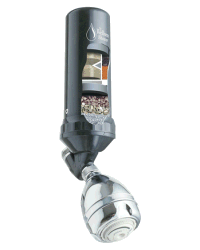High Levels of Cancer-Causing Chlorine Pollutants Found in U.S. Water Supplies
by www.SixWise.com
Chlorine is regularly used to disinfect public drinking water supplies, a measure public health officials stress is necessary to keep the water safe from various water-borne diseases. Yet, during the chlorination process toxic disinfection byproducts are created, many of which linger in the water you drink, shower and bathe with.
|

Bathing and showering in unfiltered tap water may expose you to more disinfection byproducts than drinking the water!
|
And while there are a total of 600 disinfection byproducts that have been identified by Environmental Protection Agency (EPA) scientists, legal limits for levels in tap water have been set for only 11 of them.
What is also concerning, as pointed out by the Environmental Working Group (EWG), is that legal limits, or MCL (Maximum Contaminant Level), for these toxins are “established as a balance between health, treatment cost and feasibility.” They are not, therefore, intended to be a true safe level of exposure. Instead, the MCL of a disinfection byproduct actually allows more contamination that the truly safe level, which is what the EPA calls its “public health goal.”
What are Disinfection Byproducts, and How are They Harmful?
When this chemical comes into contact with other naturally occurring elements in water, it forms dangerous byproducts which include trihalomethanes (THMs) (chloroform, bromodichloromethane, bromoform, and dibromochloromethane) and haloacetic acids (HAAs) (monochloroacetic acid, dichloroacetic acid, trichloroacetic acid, monobromoacetic acid and dibromoacetic acid). These compounds have been linked to the following health concerns:
- HAAs (current MCL 60 ppb): Classified by the EPA as possibly carcinogenic to humans because of evidence of carcinogenicity in animals, studies have linked HAAs with an increased risk of cancer, and injury to the brain, nerves, liver, kidneys, eyes and reproductive systems.
Further, EWG points out that evidence has shown that exposure to HAA during the second and third trimesters of pregnancy may be linked to intrauterine growth retardation and low birth weight. Certain HAAs have also been linked to a disturbance in the balance of the intestinal tract, which could increase the risk of pathogenic bacteria causing illness, particularly in those with compromised immune systems. They have also been shown to be toxic to the sperm of rats at concentrations as low as 10 parts per billion, and to cause a range of neurological effects.
- THMs (current MCL 80 ppb): Studies have linked THMs with low birth weight and neurological abnormalities in infants, along with increased incidences of neural tube defects, small body length, and small head size in women drinking water containing 400 ppb THMs. Research has also linked an increased risk of bladder cancer with exposures of 50 ppb, and first trimester miscarriage in pregnant women drinking water with 75 ppb.
Levels of THMs between 80 and 100 ppb and above are associated with increased incidences of neural tube, central nervous system, and major cardiac birth defects.
How High are Levels in Your Tap Water?
A recent study by EWG tested disinfection byproducts levels from 19 locations around Washington D.C. They found that 42% of the samples had HAA concentrations higher than the EPA’s legal annual limit for these compounds. For THM concentrations, all were below the EPA’s MCL, however, 89% were above the level (40 ppb) that studies have associated with adverse health effects in infants, ranging from low birth weight to neurological abnormalities.
Meanwhile, samples from tap water in Columbia, MO found THMs at 101 ppb, which exceeds the EPA’s MCL.
|

Leaving drinking water to sit out in an open pitcher for three to four hours may help reduce levels of THMs.
|
How can you find out what levels are like in your area? Your water supplier is required to send you an annual water quality report each year by July 1. You can also find your drinking water quality report by state using this map from the EPA.
Two Routes of Exposure: It’s Not Just Your Drinking Water That’s a Concern
While filtering your home’s drinking water is an important step to help remove contaminants, this will not remove the toxins in the water you shower and bathe in.
Studies show that showers and baths may contribute more to your total exposure to THMs and other disinfection byproducts than drinking water. When you shower or take a bath, the warm water opens up your skin's pores, making it like a sponge for chlorine. Meanwhile, the steam in your shower, which you readily inhale, is full of chlorine and its byproducts as well. Since your skin is the largest organ of your body, some estimates say that steam can transport into your body up to 100 times the toxic chemicals as you would get from drinking tap water.
A Two-Pronged Approach is Best to Protect Your Health
This is why EWG recommends filtering not only your home’s drinking water, but also the water you shower or bathe with.
“Consumers should consider purchasing a whole-house filtration system if they want to protect themselves from DBP-related health effects to the fullest extent possible,” they write on their Web site.
The two options that Sixwise.com highly recommend come from Wellness, which produces both The Wellness Shower Filter and The Wellness Kitchen Water Filter.
The Wellness Kitchen combines the best filtration and enhancement technologies to deliver the purest and most natural tasting water available. It effectively reduces harmful contaminants, including chlorine and THMs, while at the same time enhancing the water with adding important yet delicate wellness "ions and minerals" that your body needs.
Meanwhile, The Wellness Shower effectively reduces up to 99 percent of chlorine from your shower's water for up to 24 months, which is two or three times longer than any other shower filtration system available. But that's not all.
The Wellness Filter concept was developed in the 1980s by Harusuke Naito, a renowned Japanese sports physiologist and Olympic swimming coach who wanted to produce "perfect water" for his professional athletic clients.
|
Shower in the Luxury of PURE Water

The Wellness Shower effectively reduces up to 99% of chlorine for 24 months AND increases hydration of your skin and hair by 115 percent. You'll notice the difference in your skin and hair after just one bath or shower.
Order The
Wellness Shower Filter Now!
|
Haru believed that even subtle differences in water purity, surface tension and mineral content could affect body hydration, cellular function, and athletic performance. After extensive field research and study he began experimenting with various natural filtering media in an effort to produce the world's best water.
Taking Water to Another Level
The Wellness Filter is now widely known for its ability to enhance water beyond the reach of conventional water purification systems.
At the heart of its enhancement ability is an array of permanent, exotic media that until recently have not been seen outside of Japan. After the water is purified, these media induce into the water a unique combination of water-soluble trace minerals and ions that Japanese researchers believe aid the body's biochemical functions and cellular health.
In addition, the filter also contains a special far-infrared emitting ceramic media, which imparts reduced ions into the water. These ions provide a mild antioxidant effect in the body when consumed and on the skin when bathing. This aids your body in neutralizing free radicals, which are believed to be a primary factor in aging and in the development of cancer.
You owe it to yourself, and your family, to shower in, and drink, only pure water. To find out more about the Wellness Kitchen Filter and Shower Filter, you can visit their site now.
Recommended Reading
Is it Time to Give Up Bottled Water? The Facts, Marketed Illusions, and Health Risks You May Not Know About
Five Things to be Cautious of Regarding Your Tap Water and the Safer Alternatives
Sources
Columbia Missourian July 15, 2008
Environmental Working Group: Chlorine Pollutants at High Levels in DC Tap Water